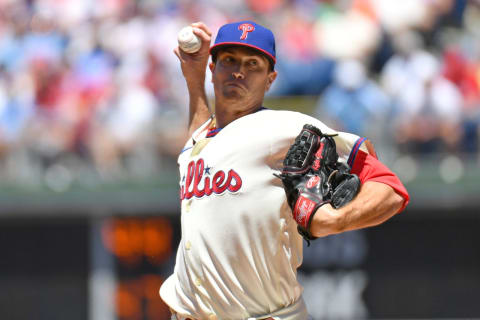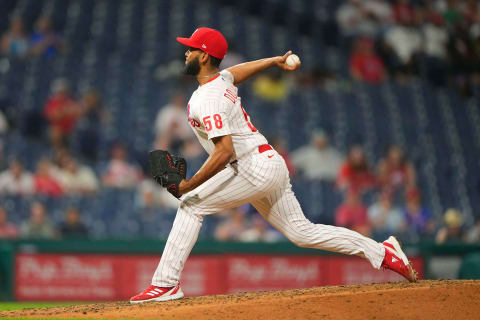Philadelphia Phillies: A deep dive into “awful” pitching

The remarks are tossed out casually about the Philadelphia Phillies. “This is a flawed team.” “This sure ain’t a perfect team.” “The bullpen is awful.” “I’m not sure there’s a real number one in the rotation.” Sports-talk radio hosts and their guests all have generalized evaluations all the time.
So do those on social media and those employed by the mainstream media.
Since the team is, as this is typed, sitting in third place in the NL East at 28-29, there is something to some of the above remarks. Those ugly comments have been paused for a short period because of the firing of Joe Girardi and the initial success of interim manager Rob Thomson, but such remarks are never entirely absent.
How awful is the Phillies bullpen, or for that matter, their entire pitching staff?
For example, one Phillies fan, in the middle of the current winning streak, felt compelled to point out that on June 8 in 1974, an obscure Reds catcher, Bill Plummer, homered twice off the greatest Phillies pitcher ever, Steve Carlton. His deathless further observation was that those two homers represented 14 percent of Plummer’s career total.
Philadelphia.
Let’s pick at the sad evaluations of the current Phillies hurlers for a bit. Just how bad are they thus far, to focus?
During their current winning streak, which began June 1, their starters had averaged over six innings per outing, according to Tom McCarthy on the NBC Sports Philly broadcast from Milwaukee on June 9. So, right now, the starters are doing their jobs in modern terms.
Of course, that innings-per-start number fell on Thursday, as starter Zach Eflin only lasted four frames.
A deeper dive into the starters for the Phillies reveals nothing much surprising in terms of won-lost and ERA numbers at this junction. Last year’s Cy Young runner-up, Zack Wheeler, is 4-3, with a respectable 3.14 ERA. He is followed by putative number two, Aaron Nola at 4-4 and 3.50, then Zach Eflin, Kyle Gibson, and Ranger Suarez – together 9-9, with ERAs of 3.76, 4.40, and 4.42, respectively.
In other words, a .500 team’s record is reflected in their starters. They are 17-16, a tiny bit better than the team record. But how tiny is that bit really?

Deeper on the Starters
From the above figures, spot starts by two other pitchers were excluded since they were not expected to go deep into their starts. They are Cristopher Sanchez and Bailey Falter. Sanchez lost the game he started although he gave up only two runs in 2.1 innings against the Mets on May 8. Falter lost one of his two starts, giving up five runs, but only two were earned – a telling statistical tidbit.
So, do the starters, then, fall to 17-18? That could be argued either way. Phillies starters are, for argument’s sake, one game under .500, just like the team (after play on June 9).
But what about other important peripheral numbers, and let’s stick to the real starters at this point. Are the Phillies starters a tiny bit better than their team or not?
Three of the starters’ batting averages against – Nola’s, Wheeler’s, and Eflin’s – are quite good, .205, .240, and .248, respectively. They all surrender less than one hit in every four opponent at-bats. These figures are reflected in their fine WHIP figures – again, respectively, 0.88, 1.17, and 1.18. Gibson’s and Suarez’s OBAs and WHIPs are .256 /1.27 and .272/1.47, respectively.
However, the most telling figures are the starters’ fielding independent figures (FIPs). Nola, so far this season the Phillies workhorse starter with 6.1 innings per start, has a 3.25 FIP, 0.25 better than his ERA. In other words, with better defense, Aaron Nola would be giving up one less run every 36 innings he throws.
Suarez’s FIP is 0.34 better than his ERA but is nothing in terms of drama compared to the FIPs posted by Gibson, Wheeler, and Eflin – 0.94, 0.84, and 0.84 better, respectively, than their ERAs. Each is, therefore, with a better Phillies defense, likely to give up one less run every 11 to 12 innings pitched.
Thus, it would seem the Phillies starters are a bit more than a tiny bit better than is reflected in the team’s record so far.
However, how about the widely condemned Phillies bullpen, a group that, no matter the make-up, has been criticized for several years running now?

The Bullpen
At this point, the list of Phillies pitchers not considered regular starters includes 13 individuals. Some of these players spend a lot of time traveling between Philadelphia and their “homes” closer to Coca-Cola Park in Allentown, PA, where the Phillies’ Triple-A team plays.
Of these players, seven relievers have pitched more than 15 innings, and are clearly the players leaned on by the Phillies managers and coaches. Four have pitched at least one inning every three games. They are the closer, Corey Knebel (24 innings), Nick Nelson (28.2 IP), Seranthony Dominguez (21.2 IP), and Jeurys Familia (21 IP).
Among those seven pitchers favored, only one has a WHIP below the MLB average (1.267), Dominguez at 0.969, although Andrew Bellatti is very close to the average figure at 1.269. However, all seven of the relievers favored so far by the Phillies have ERAs below the league average (3.97), and an argument can be made that ERA is more important than WHIP among relief pitchers.
After all, no one really remembers the runner put on base by a closer if he records a save. What is remembered is the reliever who puts three runners on base and records a save, something Knebel has done this season (June 7). Such a reliever, of course, tends not to be perfect in save situations, and the Phillies closer has not been.
But Knebel has collected 10 of his possible 13 saves, and behind him – or rather, usually before him – are Dominguez with his 1.66 ERA and Brad Hand at 1.13. Batting averages against Knebel, Dominguez, and Hand are, respectively, .218, .184, and .214.
So, call the Phillies bullpen average if you must, but they are not really worse than that.
One fact of the matter is that this is roughly where Phillies pitching has been for several years – above average starters and average relievers, and in fact, this year’s starters are somewhat better so far in terms of numbers than the squads of some other recent campaigns.
Another fact of the matter is that the 2022 Phillies were built to take such a pitching corps to the playoffs by an improved offense, and thus far that hasn’t exactly happened, Bryce Harper excepted.
Girardi and the no-contact Phillies. dark. Next
Also, a pitcher is only as good as the fielders behind him, and in the Phillies’ case, the pitchers have too frequently been hamstrung by their defense. So far, under interim manager Thomson, they seem to be kicking or missing fewer batted balls. That needs to continue.